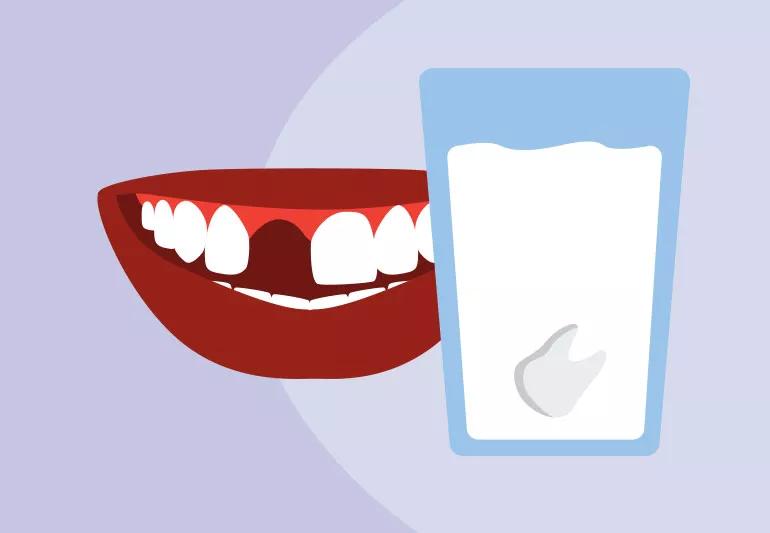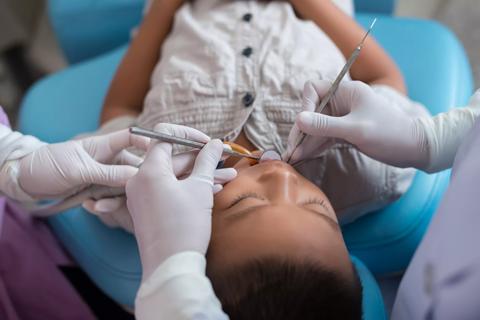Act quickly to increase the chances that your tooth can be saved

Losing your baby teeth is an exciting rite of passage that sometimes leads to under-the-pillow gifts from the Tooth Fairy. Losing an adult tooth, on the other hand, is an emergency-level dental crisis.
Advertisement
Cleveland Clinic is a non-profit academic medical center. Advertising on our site helps support our mission. We do not endorse non-Cleveland Clinic products or services. Policy
It’s common for kids to get hurt during contact sports and everyday play (hello, stitches and broken bones). One of the main areas of damage is often the face, making athletic injuries a major link between sports and dentistry. And of course, teens and adults can also sustain injuries to the face that lead to a knocked-out tooth — also known as an avulsed tooth.
If your tooth is chipped, gather up the broken pieces and take them to the dentist for repair. But if an entire tooth has been knocked out, it’s important to act swiftly and carefully to increase its chances of being saved and re-implanted.
“Time is an important factor in the survival of the tooth,” stresses dentist Todd Coy, DMD. If the tooth is replaced into the socket or placed in proper storage within five minutes of being knocked out, it’s likely it will survive.
Between five and 60 minutes, there continues to be a good survival rate, as long as the tooth has been stored properly. But if the tooth is out of the mouth and dry for more than 60 minutes, its chance for survival decreases significantly.
So, what’s your starting step when a tooth goes flying? If it’s your kiddo who’s lost it, first double-check to see whether it’s a baby tooth or an adult tooth. Baby teeth aren’t re-implanted, so in that case, you’ll likely just wait for their adult (permanent) tooth to grow in.
Advertisement
“You should still contact your dentist right away to make sure there are no fragments in the gum or lip, as well as to plan to maintain proper space for the permanent tooth to grow in,” Dr. Coy advises.
When a permanent tooth is knocked out, your first focus should be on finding the tooth. If it’s been left on the field or the court, you’ll want to locate it ASAP.
No, you can’t re-implant your tooth on your own. But by putting it immediately back into the socket (the gaping hole in your mouth where your tooth once lived), you give it the best chance of survival until you get emergency care.
“If the tooth is visibly soiled, first rinse it briefly with tap water or with milk,” Dr. Coy instructs. Don’t scrub or soak the tooth, and don’t wipe it down or wrap it in paper towels or cloth.
Once it’s clean, use your fingers to gently push the tooth back into its socket. Very lightly close your mouth to lodge it in place, but don’t shove or force it if it won’t go back into place.
And when you’re handling a knocked-put tooth, make sure you’re very careful.
“Never touch the tooth by the root,” Dr. Coy warns. “The root contains important fibers called periodontal ligaments, which are necessary for proper healing.” Instead, handle the tooth by the crown (the chewing surface area). There aren’t any exposed roots there.
“Whether or not you can put the tooth back into the socket, go immediately to a dentist or the nearest emergency department,” Dr. Coy says. “If possible, be sure to take the tooth with you.”
When you’re en route to medical care, the tooth needs to be kept moist, which will give it the best chance of reimplantation.
You can “store” the tooth between your gums and cheek, where your saliva will moisten it. But you also have to be very careful not to accidentally swallow it, so this isn’t an ideal option — especially for kids.
But whatever you do, do not put your knocked-out tooth in water, tap or otherwise. Its roots can’t handle water exposure for that amount of time.
Instead, your best bet is to put it in milk.
We know it sounds weird, but putting your knocked-out tooth in milk is the No. 1 way to keep it intact for your dentist or endodontist.
“The makeup of milk helps maintain the periodontal ligaments so you have a better chance of successful reimplantation,” Dr. Coy explains.
Put the tooth in a small food storage container filled with enough milk to keep it covered. It’s best to use a container with a lid so you don’t risk spilling it and losing the tooth while you’re in transit.
Advertisement
Another option is to use an emergency tooth preservation kit, which can be purchased independently or found in some first aid kits. These small, fluid-filled jars keep your tooth moist and sustained until you can get to medical care. If you’re reading this article, though, it may already be too late for you to access one — so milk is the way to go.
Keep your tooth in milk until you reach the emergency department or other emergency dental care, where a medical professional will assess whether the tooth is able to be re-implanted.
“You have the best shot at successful re-implantation if you reach emergency care within half an hour,” Dr. Coy reiterates.
If your tooth can be re-implanted, it will likely be splinted to the adjacent teeth for two to eight weeks, he adds. During that time, a root canal will be necessary for the tooth’s long-term survival.
According to the American Dental Association, athletes are 60 times more likely to experience dental injuries when they’re not wearing a mouth guard. A properly made mouth guard can protect teeth by cushioning the impact and dispersing forces.
The best type of mouth guard is the kind that’s custom-formed by a dentist. But even ready-made and boil-and-bite mouthguards can add a tremendous amount of protection and should be used with all contact sports with the potential for mouth injuries.
Advertisement
“Despite the best methods for saving a tooth that has been knocked out, prevention is still the best strategy,” Dr. Coy says.
Advertisement
Learn more about our editorial process.
Advertisement

The earlier they come in, the sooner they fall out

Quick action is key to preventing long-term damage

Most recommended precautions center around minimizing bruising or swelling

Even one drink can have an impact on your cognitive function leading to slurred speech, blurred vision and impaired memory

Understand who may (and may not) benefit

Lorem ipsum dolor sit amet. Et odio Quis vel ipsam omnis eum alias deleniti et placeat impedit non voluptas galisum hic autem enim et cupiditate aliquid. Est beatae quidem non facilis autem ut commodi nisi aut tempore rerum et dolores voluptatem cum enim optio id sapiente quasi. Ad laboriosam officiis 33 cupiditate sequi ea voluptatum consectetur qui necessitatibus voluptate et quasi doloremque et facere explicabo quo explicabo officia

Type 2 diabetes isn’t inevitable with these dietary changes

Applying a hot or cold compress can help with pain